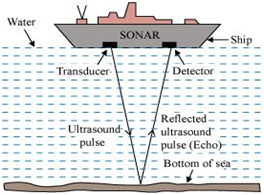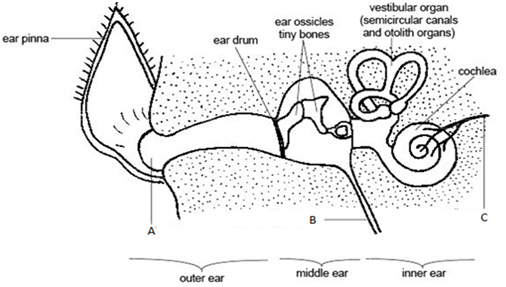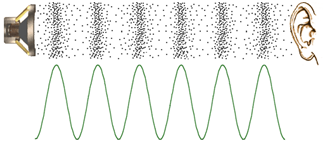MCQ Questions for Class 9 Science Chapter 12 Sound with Answers
MCQs from Class 9 Science Chapter 12 – Sound are provided here to help students prepare for their upcoming Science exam.
MCQs from CBSE Class 9 Science Chapter 12: Sound
Q1. The sound can travel in air when:
(a) Particles of medium travel from one place to another
(b) There is no moisture in the atmosphere
(c) Disturbance travel from one place to another
(d) Both particles as well as disturbance travel from one place to another
Answer/ Explanation
(c) Disturbance travel from one place to another
Q2. We can distinguish between a man’s voice and a woman’s voice of the same loudness even without seeing them. This is due to a characteristic of sound which measures the shrillness of sounds. Can you choose the correct unit of the quantity on which this characteristic of sound depends?
(a) hertz
(b) meter/second
(c) meter
(d) unitless
Answer/ Explanation
(a) hertz
Q3. A key of mechanical piano is first struck gently and then struck again but much harder this time. What kind of change in sound will you observe in the second case:
(a) Sound will be louder but the pitch will not be different
(b) Sound will be louder and the pitch will also be higher
(c) Sound will be louder but the pitch will be lower
(d) Both loudness and pitch will remain unaffected
Answer/ Explanation
(c) Sound will be louder but the pitch will be lower
Q4. The echo-receiver of a sonar attached to a ship, receives the echo from the bottom of sea 4 seconds after the ultrasonic waves were sent into the sea.

If the speed of sound in water is 1500 m/s, then what is the depth of the sea?
(a) 6000 m
(b) 3000 m
(c) 15000 m
(d) 3500 m
Answer/ Explanation
(b) 3000 m
Q5. Before the main shock waves, the earthquake produces the characteristic sound waves which some animals like rhinoceros can hear. Can you guess the kind of sound waves produced here?
(a) Infrasonic sounds
(b) Ultrasonic sounds
(c) Audible Sounds
(d) None of these
Answer/ Explanation
(a) Infrasonic sounds
Q6. Given below is the diagram of human ear. Choose the correct labeling of the parts A, B and C.

(a) A-ear lobe, B-ear canal, C-auditory nerve
(b) A-ear drum, B-auditory nerve, c-ear canal
(c) A-ear canal, B-Eustachian tube, C-auditory nerve
(d) A-ear canal, B-Eustachian tube, C-cochlea
Answer/ Explanation
(c) A-ear canal, B-Eustachian tube, C-auditory nerve
Q7. On increasing the temperature, the speed of sound in air:
(a) Increases
(b) Decreases
(c) Does not change
(d) First increases then becomes constant
Answer/ Explanation
(a) Increases
Q8. Loudness measures the sound energy reaching the ear per second and depends on the amplitude of the sound wave. What is the unit used to measure the loudness of sound?
(a) hertz
(b) decibel
(c) meter/second
(d) second
Answer/ Explanation
(b) decibel
Q9. We can easily distinguish between the sounds of the different singers even without having seen them. This is all due the different quality or timber of their sounds. On what factor does the quality of sound depend?
(a) Wavelength
(b) Waveform
(c) Wave frequency
(d) Wave amplitude
Answer/ Explanation
(b) Waveform
Q10. Before playing the orchestra in a musical concert, a sitarist tries to adjust the tension and pluck the string suitably. By doing so, he is adjusting
i. Amplitude of the sound
ii. Frequency of the sitar string with the frequency of other musical instruments
iii. Intensity of sound
iv. Loudness of sound
Choose the correct option:
(a) (i) and (iii)
(b) only (ii)
(c) (ii) and (iv)
(d) only (iv)
Answer/ Explanation
(b) only (ii)
Q11. The bats can fly in the darkness of night without colliding with the other objects by emitting special sounds while flying. Which characteristic of sound is used by the bats to navigate?
(a) Ultrasound
(b) Infrasound
(c) Audible sound
(d) None of these
Answer/ Explanation
(a) Ultrasound
Q12. The sound travels from particle to particle in the form of vibrations and has different speeds in different mediums.

The maximum speed of vibrations which produce audible sound will be in:
(a) Sea water
(b) Ground glass
(c) Human blood
(d) Dry air
Answer/ Explanation
(b) Ground glass
Q13. Which of the following can produce longitudinal as well as transverse waves under different conditions?
(a) Bats
(b) Slinky
(c) Tuning fork
(d) None of these
Answer/ Explanation
(b) Slinky
Q14. If the speed of a wave is 380 m/s and its frequency is 1900 Hz, then the wavelength of the wave will be:
(a) 20 m
(b) 0.2 m
(c) 200 m
(d) 2 m
Answer/ Explanation
(b) 0.2 m
Q15. You must have seen the doctor checking the sounds produced in the chest or heartbeat of a patient using a medical instrument called Stethoscope. On what principle does this Stethoscope work?
(a) Multiple refractions
(b) Multiple reflections
(c) Wave motion
(d) None of these
Answer/ Explanation
(b) Multiple reflections
